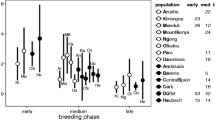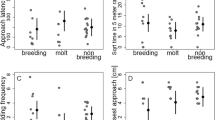Summary
In many vertebrates, seasonal activation of sexual and territorial behaviors coincides with seasonal gonadal activation and is caused by the increase in sex steroid hormones. Both male and femaleSceloporus jarrovi are territorial, but in this species territorial behavior is seasonally activated in late April, months before seasonal gonadal maturation, which occurs in August prior to the fall mating season. Measurements of seasonal changes in circulating levels of the sex steroid hormones testosterone, progesterone, and estradiol indicated that testosterone levels in both sexes are elevated when territorial behavior is expressed, even during the period of nonbreeding-season territoriality during the summer. This suggests that a nonbreeding season behavior is activated by a sex steroid hormone in this species.
Similar content being viewed by others
References
Burger AE, Millar RP (1980) Seasonal changes of sexual and territorial behavior and plasma testosterone levels in male lesser sheathbills (Chionis minor). Z Tierpsychol 52:866–874
Caldwell GS, Glickman SE, Smith ER (1984) Seasonal aggression independent of seasonal testosterone in wood rats. Proc Natl Acad Sci USA 81:5255–5257
Crews D (1984) Gamete production, sex hormone secretion and mating behavior uncoupled. Horm Behav 18:22–28
Crews D, Moore MC (1986) Evolution of mechanisms controlling mating behavior. Science 231:121–125
Dryden GL, Anderson JN (1977) Ovarian hormone: Lack of effect on reproductive structures of female Asian musk shrews. Science 197:782–784
Feder HH (1984) Hormones and sexual behavior. Annu Rev Psychol 34:165–200
Goldberg SR (1970) Seasonal ovarian histology of the ovoviviparous iguanid lizard,Sceloporus jarrovi. J Morphol 132:265–276
Goldberg SR (1971) Reproductive cycle of the ovoviviparous iguanid lizardSceloporus jarrovi. Herpetelogica 27:123–131
Guillette LJ, Spielvogel S, Moore FL (1981) Luteal development, placentation, and plasma progesterone concentration in the viviparous lizardSceloporus jarrovi. Gen Comp Endocrinol 43:20–29
McNichol D, Crews D (1979) Estrogen/progesterone synergy in the control of female sexual receptivity in the lizard,Anolis carolinensis. Gen Comp Endocrinol 38:68–74
Moore MC (1982) Hormonal response of free-living male white-crowned sparrows to experimental manipulation of female sexual behavior. Horm Behav 16:323–329
Moore MC (1983) Effect of female sexual displays on the endocrine physiology and behaviour of male white-crowned sparrows,Zonotrichia leucophrys. J Zool (Lond) 199:137–148
Moore MC (1984) Changes in territorial defense produced by changes in circulating levels of testosterone: A possible hormonal basis for mate-guarding behavior in white-crowned sparrows. Behaviour 88:215–226
Moore MC, Kranz R (1983) Evidence for androgen independence of male mounting behavior in white-crowned sparrows (Zonotrichia leucophrys gambelii). Horm Behav 17:414–423
Moore MC, Whittier JM, Crews D (1985) Sex steroid hormones during the ovarian cycle of an all-female, parthenogenetic lizard and their correlation with pseudosexual behavior. Gen Comp Endocrinol 60:144–153
Ruby DE (1978) Seasonal changes in territorial behavior of the iguanid lizardSceloporus jarrovi. Copeia 1978:430–438
Silverin B, Viebke P-A, Westin J (1984) Plasma levels of luteinizing hormone and steroid hormones in free-living winter groups of willow tits (Parus montanus). Horm Behav 18:367–379
Wingfield JC (1983) Environmental and endocrine control of avian reproduction: An ecological approach. In: Mikami S, Homma K, Wada M (eds) Avian endocrinology: Environmental and ecological perspectives. Japan Scientific Societies Press, Tokyo, and Springer, Berlin Heidelberg New York Tokyo, pp 265–288
Wingfield JC, Farner DS (1975) The determination of five steroids in avian plasma by radioimmunoassay and competitive protein-binding. Steroids 26:311–327
Author information
Authors and Affiliations
Rights and permissions
About this article
Cite this article
Moore, M.C. Elevated testosterone levels during nonbreeding-season territoriality in a fall-breeding lizard,Sceloporus jarrovi . J. Comp. Physiol. 158, 159–163 (1986). https://doi.org/10.1007/BF01338559
Accepted:
Issue Date:
DOI: https://doi.org/10.1007/BF01338559




